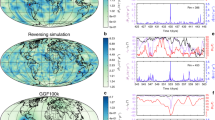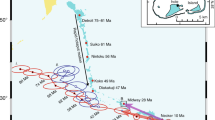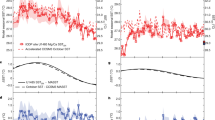Abstract
HISTORICAL geomagnetic measurements covering the past 400 years reveal a symmetrical pattern of four relatively stationary flux concentrations ('lobes') at the surface of the liquid core and regions of rapid change extending from the Atlantic to the Indian Ocean1. Palaeomagnetic data define a time-average over several thousand years2 which might reflect the stationary parts of the present field, but unfortunately the historical record is too short to provide a satisfactory average3. Here we model palaeomagnetic directions from the past 2.5 Myr using the same methods as for modern data4, and find the two northern lobes in the same position as today, over Arctic Canada and Siberia. In southern regions, by contrast, the field appears to have been smoothed out, as might be expected from the current rapid secular variation1. We propose that the present geomagnetic field morphology and pattern of secular variation have persisted for several million years, as would occur if the solid mantle controls flow at the top of the core.
This is a preview of subscription content, access via your institution
Access options
Subscribe to this journal
Receive 51 print issues and online access
$199.00 per year
only $3.90 per issue
Buy this article
- Purchase on Springer Link
- Instant access to full article PDF
Prices may be subject to local taxes which are calculated during checkout
Similar content being viewed by others
References
Bloxham, J. & Gubbins, D. Nature 317, 777–781 (1985).
Merrill, R. T. & McElhinny, M. W. in The Earth's Magnetic Field (Its History, Origin and Planetary Perspective) (Academic, San Diego, 1983).
Gubbins, D. J. geophys. Res. 93, 3413–3420 (1987).
Bloxham, J., Gubbins, D. & Jackson, A. Phil. Trans. R. Soc. 329, 415–502 (1989).
McFadden, P. L., Merrill, R. T., McElhinny, M. W. & Lee, S. J. geophys. Res. 96, 3923–3933 (1991).
Schneider, D. & Kent, D. V. Ref. Geophys. 28, 71–96 (1990).
McElhinny, M. W. in Paleomagnetism and Plate Tectonics (Cambridge Univ. Press, 1973).
Laj, C., Mazaud, A., Weeks, R., Fuller, M. & Herrero-Bervera, E. Nature 351, 447 (1991).
Clement, B. M. Earth planet. Sci. Lett. 104, 48–58 (1991).
Zhang, K. & Gubbins, D. J. Fluid Mech. 250, 209–232 (1993).
Livermore, R. A., Vine, F. J. & Smith, A. G. Geophys. J. R. astr. Soc. 73, 153–171 (1983).
Coupland, D. H. & van der Voo, R. J. geophys. Res. 85, 3529–3548 (1980).
Constable, C. G. Nature 358, 230–233 (1992).
Gubbins, D. & Coe, R. Nature 362, 51–53 (1993).
Tric, E. et al. Phys. Earth planet. Inter. 65, 319–336 (1991).
Author information
Authors and Affiliations
Rights and permissions
About this article
Cite this article
Gubbins, D., Kelly, P. Persistent patterns in the geomagnetic field over the past 2.5 Myr. Nature 365, 829–832 (1993). https://doi.org/10.1038/365829a0
Received:
Accepted:
Issue Date:
DOI: https://doi.org/10.1038/365829a0
This article is cited by
-
Observations and Models of the Long-Term Evolution of Earth’s Magnetic Field
Space Science Reviews (2010)
-
Theory and Modeling of Planetary Dynamos
Space Science Reviews (2010)
Comments
By submitting a comment you agree to abide by our Terms and Community Guidelines. If you find something abusive or that does not comply with our terms or guidelines please flag it as inappropriate.



